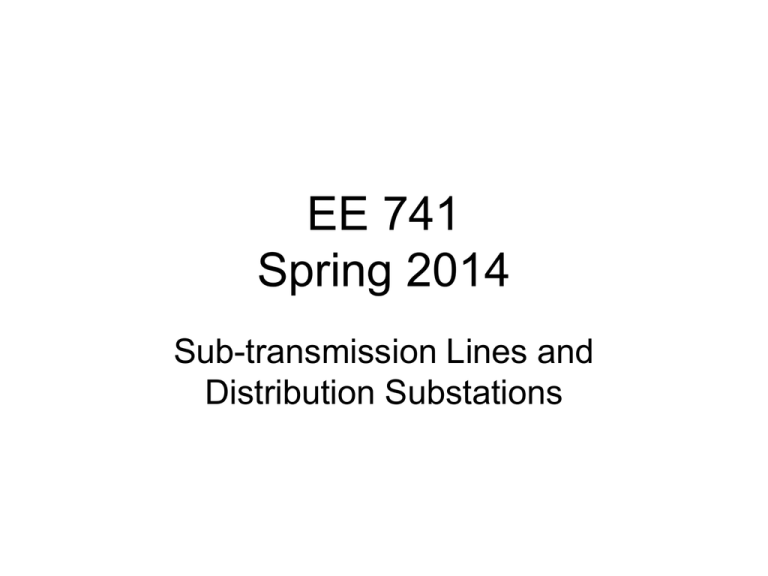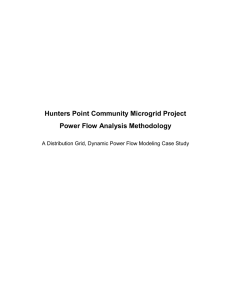EE 741 Spring 2014
advertisement

EE 741 Spring 2014 Sub-transmission Lines and Distribution Substations Overview • • • • • • • • • Types of sub-transmission layouts Substation equipment Substation bus schemes Substation location Substation rating (voltage drop calculations.) Substation application curves SCADA Substation Automation Grounding One-Line Diagram of Distribution System Radial-Type Sub-transmission • Simple and low cost • Low service continuity • Usually not employed due to poor service reliability Improved Radial-Type Sub-transmission • Simple but with higher cost • Allows relatively faster service restoration when a fault occurs on one of the lines Loop-Type Subtransmission • Higher service reliability • No single fault on any circuit will interrupt service to a distribution substation Network-Type Subtransmission • Multiple bulk power sources • Greatest service reliability • Costly control of power flow and relaying Distribution Substation Equipment • • • • • • • • • • • • • • Power Transformers Circuit Breakers Disconnecting switches Station buses Insulators CTs and PTs Lightning arrestors Protective relaying Instrumentation Station batteries Communications equipment Grounding systems Shunt capacitors Other apparatus… Single-Bus Scheme • Lowest cost • Failure of bus or circuit breaker results in shutdown of entire substation Double-Bus-Single-Breaker Scheme • Either bus may be isolated for maintenance • Four switches are required per circuit Double-Bus-Double-Breaker Scheme • Any breaker or bus can be taken out of service without power interruption • Most expensive Main-and-Transfer-Bus Scheme • Any breaker can be taken out for service Ring-Bus Scheme • Requires only one breaker per circuit • Protective relaying circuitry can be complex Breaker-and-Half Scheme • Most flexible operation • Relaying and automatic re-closing is somewhat involved Substation Location • Rules of selecting an ideal substation location: – As close as possible to the load center – Proper voltage regulation can be obtained without expensive measures – Easy access to incoming subtransmission lines and outgoing distribution feeders – Enough space for future expansion – Location should not be opposed by neighbors, local ordinances, and land use regulations – Minimize the number of customers affected by service discontinuity – Easy access (for service and emergency). Voltage Drop Calculations on Main Feeder: lumped load d R = dr, X = dx Sr = 3-phase load VD Vs Vr IR cos IX sin VD pu dS r (r cos x sin ) 3Vr 1000(r cos x sin ) dKS r , K 3VrVB K is a function of conductor size, spacing, power factor and operating voltage. VB : base phase voltage d: effective length of the feeder (r and x are in Ω/mile) Constant K:% Voltage Drop per kVA.mi Spacing = 37 in Voltage Drop (VD): Uniformly Distributed Load d ½d S A D (kVA), VD (%) D: load density VD: voltage drop on at end of feeder. 1 dKS 2 Voltage Drop (VD) in Feeder with Linearly Increasing Load Density S 4 A4 D l42 D (kVA), 2 VD (%) l4 KS 4 0.667 KDl43 3 l (↔ d): main feeder length D: load density VD: voltage drop on primary feeder. Voltage Drop (VD) in Feeder with Linearly Increasing Load Density S 6 A6 D 1 2 l6 D (kVA) 0.578l62 D (kVA) 3 2 VD (%) l6 KS 6 0.385KDl62 3 Voltage Drop (VD) in Feeder with Linearly Increasing Load Density S n An D ln2 tan( )D (kVA) o 2 360 VD (%) ln KS n 0.667 KDln3 tan( ) 3 2n Voltage Drop (VD) in Feeder with Linearly Decreasing Load Density S 2 A2 D l22 D (kVA), 1 VD (%) l2 KS 2 0.333KDl23 3 Example VD = sKSn =1x0.01x500 = 5% VD = sKSn =(1/2)x0.01x500 = 2.5% VD = sKSn =(2/3)x0.01x500 = 3.33% VD =3% Spacing: 37” PF = 0.9 #4/0 AWG Cu VD =6% Spacing: 37” PF = 0.9 #4/0 AWG Cu



